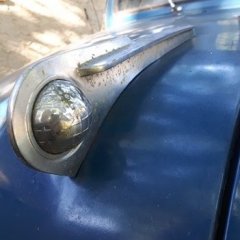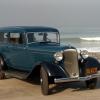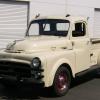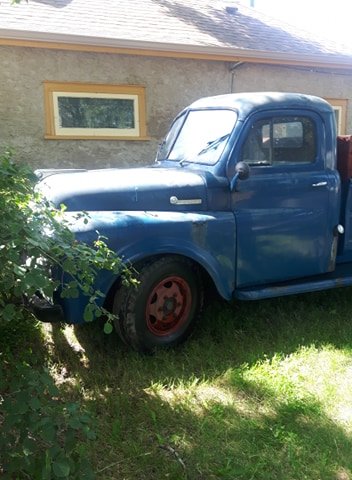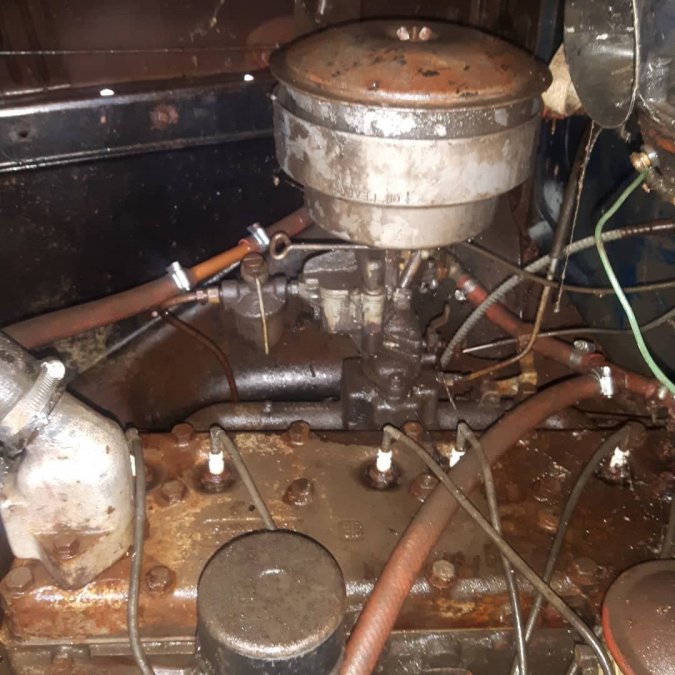Leaderboard
Popular Content
Showing content with the highest reputation on 08/05/2020 in all areas
-
3 points
-
3 points
-
Jeff, If your vehicle has been sitting for many years, especially if in an unheated or UN-air conditioned garage and it had DOT3 (hygroscopic) fluid in the system there's a high probability water has entered the system. DOT 3 absorbs water and that will corrode things. I used to watch my dad (professional mechanic) check drum brake systems. He would remove a drum and first peal back the wheel cylinder dust seals to take a peek to look for excessive corrosion, then he would take a couple of pry bars or large screwdrivers on each side of the shoes with the end of screwdrivers inside the lip of the backing plate. He would rock the pry bars back and forth slightly to see if the pistons were moving freely in both directions. On cars that had been sitting for lengthy periods it was common to find stuck pistons. You might want to try that first? DOT 5 which repels water is good for vehicles that sit for long periods, but it has disadvantages as well, most notably expands with heat more than DOT3 and can give a spongy inconsistent pedal. As far as flushing, it's not a good practice to flush the system with alcohol or other solvents. It can damage rubber components. Alchohol is good for individually flushing lines and washing metal parts before assembly. DOT 3 and DOT5 don't mix and if that should accidentally happen you'll have to do a complete disassembly to clean it all out. If you can get any fluid from your system you can add a few drops of water to it in a jar. DOT 5 will not mix with water, but DOT 3 will. New DOT 5 does have a purple color, but over time it can change to yellowish, so not a reliable way to check. I had DOT5 in my truck for thirty some years and just recently switched back to DOT 3 due to stated shortcomings. I will say that the system was like new after all that time. It has it's merits for vehicles that sit for long periods. I'm much happier with my braking performance with DOT3 but I will need to be more diligent about routinely replacing the fluid. Most car manufactures recommend changing brake fluids at prescribed intervals, but almost no one does it. If you're cylinders are all free and in like new appearance you may have had DOT5 in there. If you see some minimal corrosion but pistons are still free your probably safe with DOT 3. Make sure to bleed thoroughly and in your case look for leaks. Sounds like you likely had one.2 points
-
I'm using Wagner H6006 lamps in my 53 ... lowbeam is brighter that my original lamps ... high beam2 points
-
They are not the same wattage. Keep in mind that the issue discussed was for 1939 Plymouth. These have the old style headlights with separate lens, reflectors, bulbs, etc. If you keep these original but want a brighter bulb, you need to use a Mazda 2331 bulb. There are limited vendors who supply halogen 2331 bulbs. The vendor I mentioned above has 2 versions: 35w/35w and 35w/50w. Yep, these draw a lot of power. The calculations I used: 6 volt electrical system (positive ground) Bulbs: 35/35 watts 50/35 watts ********************************************* For 2 halogen bulbs: 70 watts 100 watts Amps = watts / volts ********************************************** 70 watts / 6 volts = 12.7 amps for 2 halogen 35 watt bulbs 100 watts / 6 volts = 16.7 amps for 2 halogen 50 watt bulbs So I went with an alternator so as not to tax the original charging system given what else it needs to do. Changing back to tungsten bulbs and generator would take about 30 minutes if I choose to do that. My ammeter certain shows the different between the tungsten and halogen bulbs. Pete2 points
-
I had my 39 P8 rebuilt over the winter. It had a brass WDT, which surprised me. It has the original 39 engine. Not sure if the WDT was original. It could have been replaced when the engine was last rebuild in the 1950's. Anyway, the tube was brass. It came out fairly easily, and looked almost new so it was reused. Since the rebuild the car's previous overheating issues seems to have gone away. One note: you may want to replace the water pump bolt closest to the generator with a stud. I had to remove that bolt to change the upper generator bracket when I installed an alternator. Because those threads go so deep I had to remove the fan and pulley to get that bolt out. A real pain to be avoided. Pete2 points
-
2 points
-
1 point
-
Check for numbers on the Alt. and counter check them against this site https://alternatorparts.com/6-volt-alternators-negative-positive-ground.html their alternators look like Delco Remys! not sure what part of the world you are in, but in my part of the world on a working truck, I'd still bet on it being a chevy alt stuck in there.1 point
-
That could be argued all day long. My opinion is that it's a matter of opinion, and not a very important matter at that. I don't see any need for both nor do I think anyone would ever notice an actual difference. The resistor wires are plenty to protect a basic electronic trigger from radio noise. It's not a full on computerized electronic ignition system. Favorite plugs I think on this forum tend to lean away from champion and towards nearly anything else. I'm a fan of NGK but that's mostly because I think they performed longest in my old 2 stroke dirt bikes.1 point
-
Delco Remy, Chevy Alternator, I'd bet a case of beer that is a 12 volt negative ground. Can you find a model number on the alt. anyplace? A good partsman should beable to tell you from that if it is an oddball. I'd (and I'm by no means an expert) make sure everything is off (no idea what you might have for accessories,) and hook it up to a 12 volt battery negative ground and see what happens, worse thing is if it is wrong you might pop the diode in the alt. just sort of touch the ground and see what happens so you can disconnect it quick if it actualy is a positive ground alt.1 point
-
Yeah! The more I'm thinking about this and remembering my dad. He probably was trying to protect me from braking my arm and having to take me to the emergency room. Did I mention I did lots of stupid stuff to endanger myself and aggravate him in the old days? Lols!1 point
-
Yes, that would be the 23" engine. As I understand it, the fluid drive cars had eight bolts holding the flywheel on but four of those match up with the four bolt crank. And when they went to 12v they changed the number of teeth on the flywheel ring gear. They may have gone to a narrow fan belt around that time too, not sure about that. Other than those items, the later 23" Plymouth and Dodge car engines should just be a bolt it operation.1 point
-
I was able to do this, as long as floor boards were still out. But i am speaking from my experience with 49 not a 41. For the woodruff, i stuck on shaft and then slipped the adjustment yoke over that. Was enough room between the frame and the end of the shaft to do this.1 point
-
Yeah I'd open the gap....don't have to but basically now you'll have the potential raise the discharge voltage from your coil, so why not, that only happens with a gap increase or some major engine mod. Even if I replaced the coil I'd probably still use a 1.5. No good dropping to .6 when either coil is likely to spark at a max of 20k on this engine anyhow.1 point
-
Negative on the pertronix Just good old points and condenser.... on a finely tuned piece of machinery, LOL (Not quite) I've also started my B3B and B4D with the hand crank, once (just so I can say I can ?)1 point
-
1 point
-
yes ACME threads, or square threads. I got mine from McMaster-Carr. I always replace all of them, just to make sure nothing will break, the keeper bit can break off leaving you a bit in the lurch with an infinite spinner. AS JB said a pack of 10 would do you just fine1 point
-
Good looking car and I see a bit of the trunk in back so it is the touring version. With respect to putting a 265 into it, better measure twice! In the very late 1930s Chrysler started building engines in Canada and all of those were the bigger 25" block. The follow on was to design the low end cars like Plymouth so they could take either engine (Dodge branding being used for Canadian Plymouths). But that all happened after your car was built. So I think it highly likely that fitting an engine two inches longer than your current one into the engine compartment will not be an easy task. It would probably be much easier to fit a 1950s US Plymouth or US Dodge car engine into your car. I believe that would be just a straight bolt in.1 point
-
The funny thing that you guy failed to read is that I don’t care about the wipers they are Vacuum wipers! I just want to switch the car to negative ground keeping the 6v1 point
-
Well that's proof enough for me. Doubt I'm going to try it though, my Fargo never started that good on the starter!1 point
-
Connection probably needs tightening if you can not see any obvious damage. They are a specialty ending and the right kind must be used or it will leak and it does need to be done up quite snugly.1 point
-
1 point
-
Perhaps our dads were pulling our legs. This video makes it look easy. I still think I'll rely on my electric starter.1 point
-
1 point
-
My truck has a fluid drive 4 speed. It was original to the truck so I kept it. It works just fine but there is more to it than a standard type clutch and transmission. Yes it is a bit easier to drive in heavy traffic.....but I wouldn't fit one to a non FD truck without very good reason. And yes the parking brake is an absolute. Jeff1 point
-
1 point
-
1 point
-
I lived in Minnesota in the '90s. An out-of-stater moved there to work with us. After a number of months he asked why so many people had burglar alarms on their cars if crime was so low where we lived. He had been looking at the AC power plugs that extended through the grille to plug in the block heaters. Pete1 point
-
I didn't check the acc pump by hand when i put it together, it did squirt fuel and did not hesitate on accleration but on the bench it was a poor spit of fuel, after moving the valves around it put out a steady stream and runs like a watch now, I would have chased this glitch for days had you not asked about the power valve. Thank you Aaron1 point
-
Trans fluid is fine, engine oil level goes down, oil residue within bell housing area. As Sniper suggested, I will clean the area and get some dye to help pin point.1 point
-
It's simple. Measure between the positive terminal on the battery and the frame. It you see positive 12 volts, then it is negative ground.1 point
-
try contacting art gould waterpump rebuilder in Mass, 1-508-210-0891 they might have a wp body gasket. the Mopar gasket number would be 637439 taken from my 39 Desoto parts manual or McCord gasket number 38315 newer mopar number 1326324 Rich Hartung Desoto1939@aol.com1 point
-
been empty for a spell, fluid unknown.....my answer is the default to good shop practices that will not waste your time and money with stop gap measures...a flush could only work if you were sure of the prior fluid...without that knowledge, tear down and clean and start anew would be my only recommendation based on cost and time involved and the assurance (as best one can get) on a good braking system.1 point
-
Ya might need to pull each wheel cylinder apart and rinse with aerosol brake cleaner, as well as the master cylinder and each short hose and hard line, with long lines flooded with brake cleaner then chased with compressed air to purge, 3 times might do the trick...allow to dry, reassemble and bleed + pressurize with DOT 3...I've read about filling and purging a system with denatured alcohol and I wonder if that damages the sealing cups in the master + wheel cylinders during pressurizing...its quicker but at what cost? Doing the complete teardown allows for inspection of components which can remove some ambiguity about system component condition. These hydraulic system either work or don't and having found out how one doesn't work while rolling down a steep hill is not something I ever want to experience again...better safe than sorry, it's cheaper in the long run1 point
-
1 point
-
These engines are in a very soft state of tune for the most part. It does not take a super hot spark to keep them happy. The real benefit of using a module like this is fewer moving parts... avoiding sub par points and condensers...and the inside of the distributor cap and rotor stay much cleaner. This is why I converted mine.....and it never fails to start and run right. Day in...day out. Jeff1 point
-
Thanks 50mech! I had too many beers last night and read the chart wrong. I apologize to everyone for confusing things more than they already are. Yes, I have the Ignitor-II module. So, according to the chart maok posted I should probably have their .45 or .6 ohm coil which gives me a hotter spark? Their .45 ohm coil however is not a round stock looking coil, so it looks like #s 45001 or 45011 flamethrower 2 coils would be the best choice for my truck. Only difference being one is chrome and one is black Summit Racing lists them having a 2.125" diameter. If that's correct, I should be able to make it fit in my oem coil bracket. Agreed? From what I'm deciphering, my 1.5 ohm coil would probably work OK without the ballast resistor, but spark would be not as hot? Am I on track here? I'll see if Pertronix confirms this.1 point
-
Possible, you might consider adding some UV die to the oil and using a black light to help track down the source.1 point
-
That's what I use as well. Works well and no more oil running all over my frame.1 point
-
1 point
-
So since your wheels are off , when you try to make your slight adjustment , turn the gears all of the way to one side and then all of the way back to the other side and count the revolutions . That way you will know where the middle is for adjustment . There has been a lot of discussion in the past on using grease that will flow in the steering boxes , such as corn head grease . If the lube doesn't flow , the bearings will suffer .1 point
-
I got the Fargo home today after 20 years or so in storage, I bought it in the mid '80s as a project for me and my Dad (he was a garage mechanic and Mopar man) just a few minor things, needs the rear end finished up, brake line and or horn. Not sure what the engine is, it was a rebuilt back in the day, and My Dad and I rebuilt it in the early '90s after a frost plug fell out and it over heated. I had lots of adventures with it, it once was my daily driver, loved it, cruising speed of 45, I have had it up to a mile a minute a few times, felt like the end of the world! Model, FM2 - 2 6 Thankyou for having me!1 point
-
The one-wire alternator I have starts charging immediately after start. I agree that it is a reliable solution to keeping the battery fully charged in our old cars under all conditions. A hot battery and the proper cables solves a lot of starting issues! ?1 point
-
Thanks for the replies, Jerry, your picture is exactly what mine looks like. I've got all of the wheels off now cleaning up and repainting them. steering box does leak the 90 weight as posted above. I'll just refill and keep an eye on it. Now that you have solved my mystery I will try to make a slight adjustment... Many Thanks, bruce dodge1 point
-
1 point
-
1 point
-
1. I would clean them up, re lubricant and re use them if it were me ? 2. Classified add like JB said 3. Nuff said.....1 point
-
1. Those appear to be brake shoe lubricating washers and covers, needed to keep the brake shoe anchor bolts lubricated and free of moisture...not sure who supplies those, but ya might have some luck placing a parts wanted add for a member who might have an old mayo jar full of'm... 2. That shock absorber bushing washer might be available if ya purchase some new shocks, though ya might want to reach out to a parts house or the manufacturer to see if you can get them...the curved shape is to match the shock rubber bushing contour and keep the bushing and the shock from moving laterally... 3. Those 4 marks are evidence of staking with a cold chisel...this deforms the seal flange and its mounting surface enough to lock the seal in place so it will not spin nor pop out of its bore1 point
-
1 point

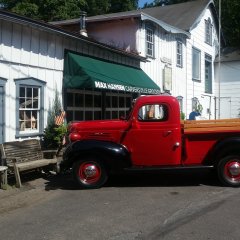


.jpg.a1d26238645b521927a3837c62947700.jpg)


